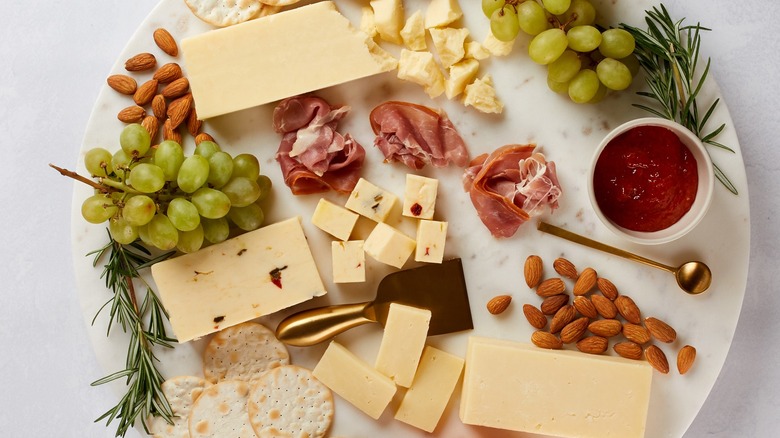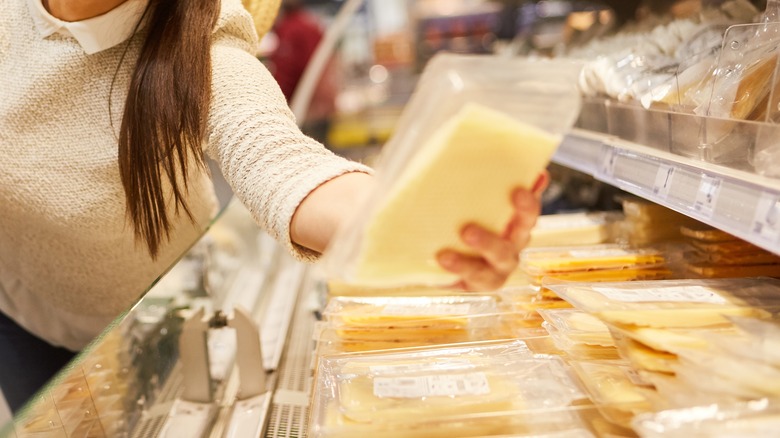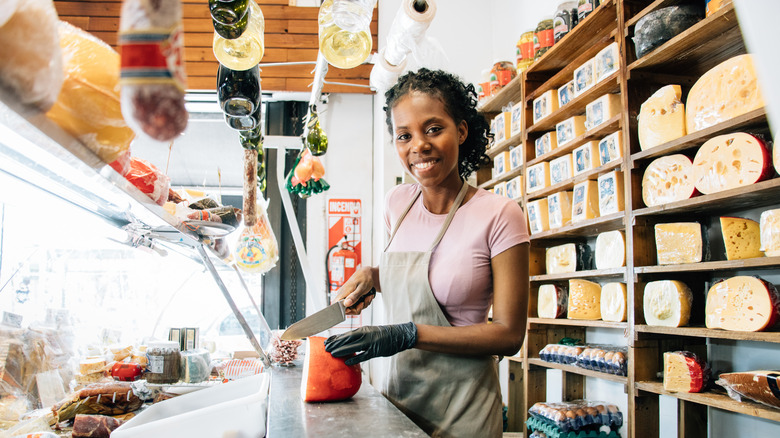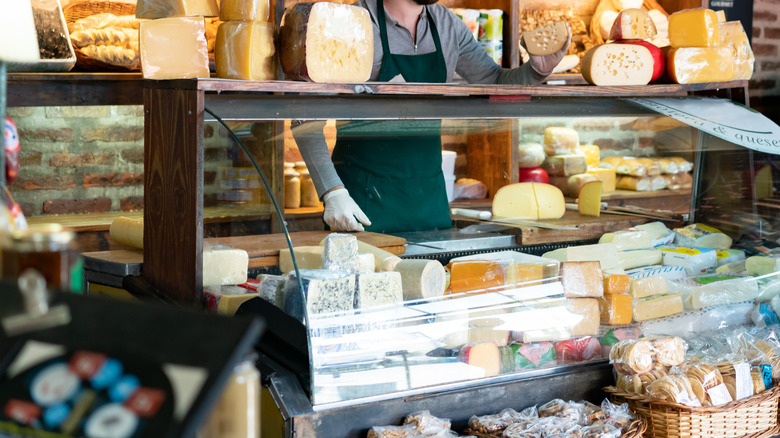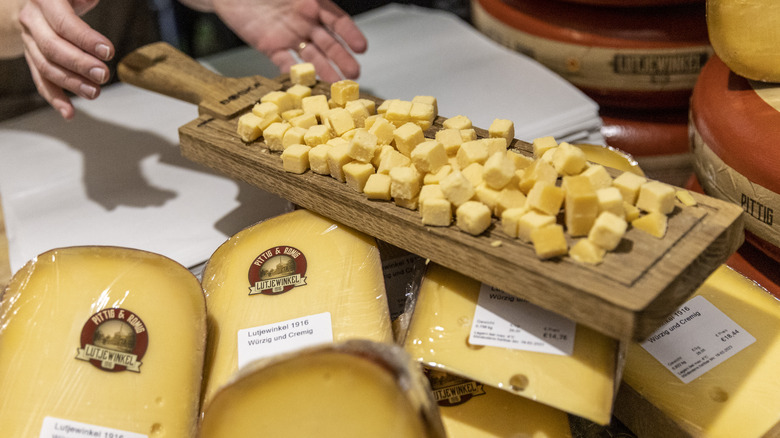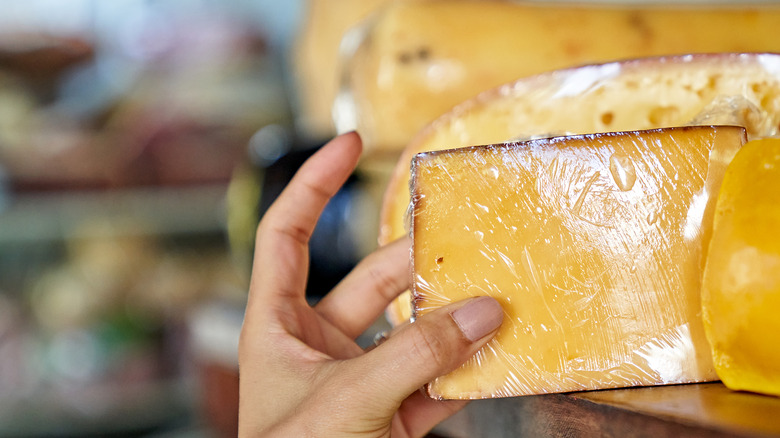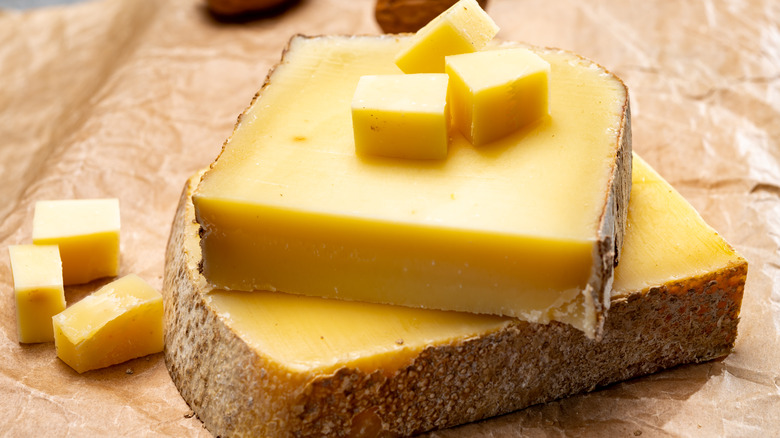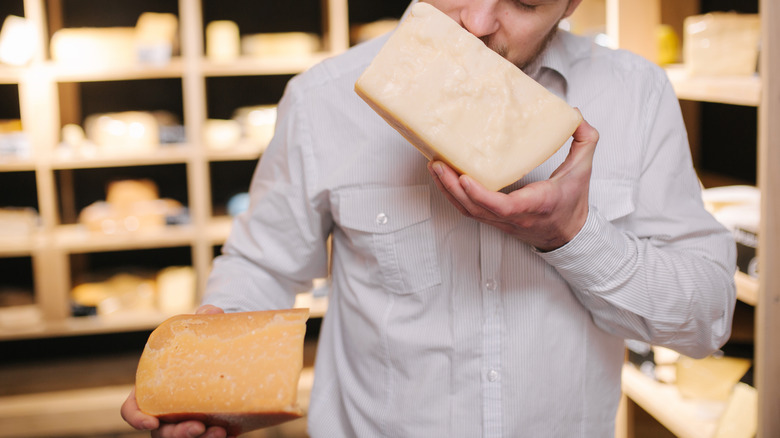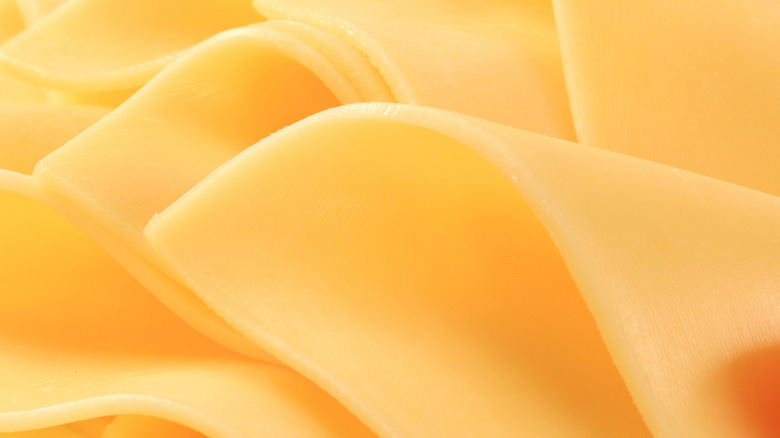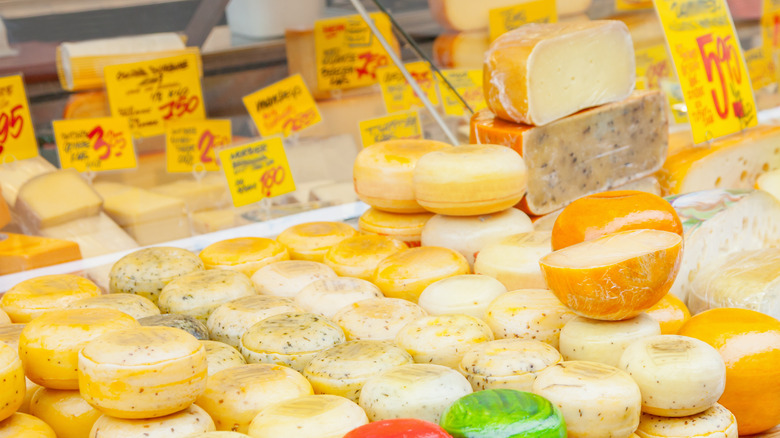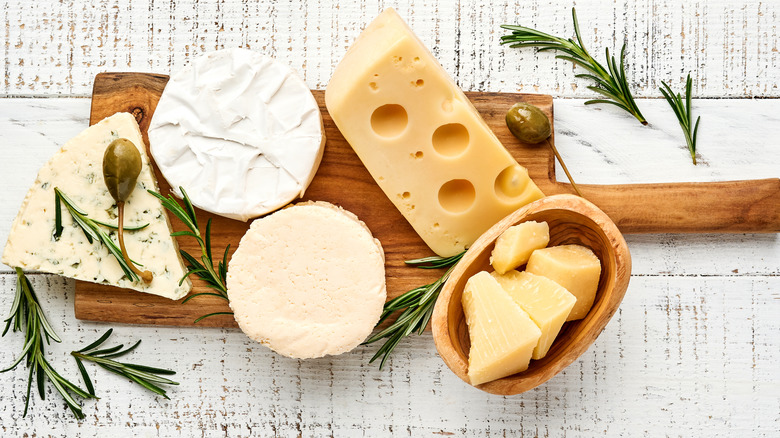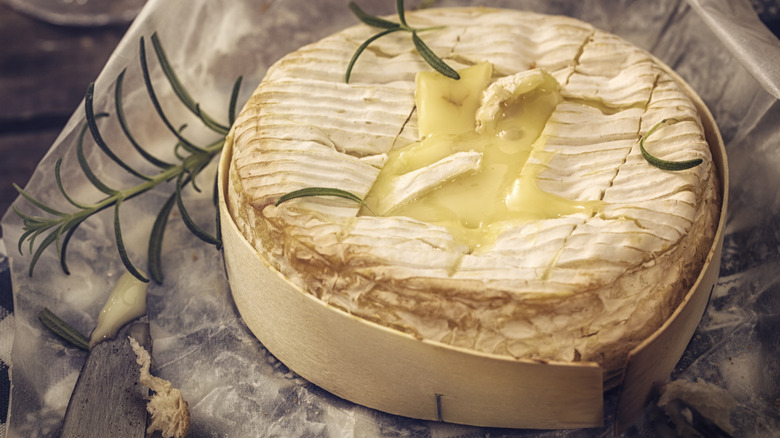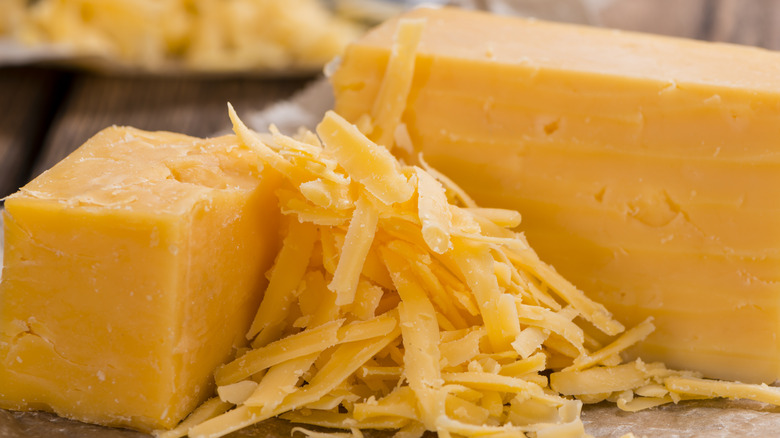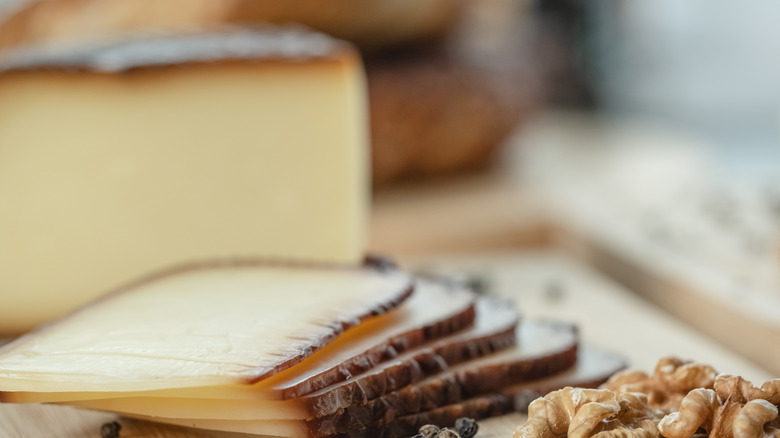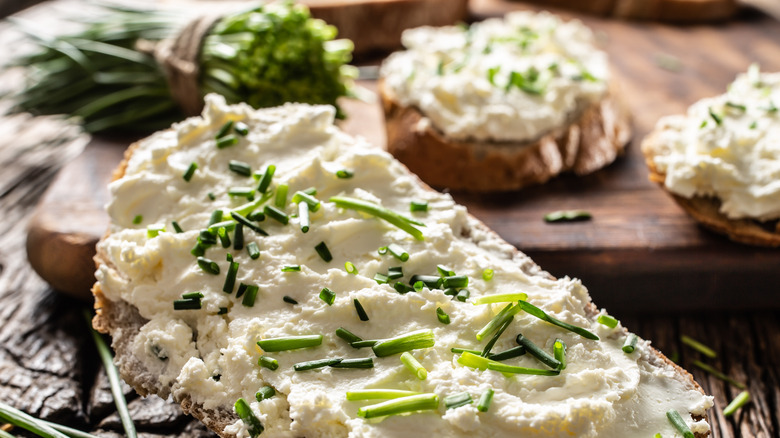16 Tips You Need When Buying Cheese At The Grocery Store
Craig Gile has been doing the cheese thing at Cabot Creamery Cooperative since 2003. Between 2006 and 2014, the cheese expert worked as a cheese grader, carrying around a T-shaped cheese trier in a holster to take small samples from Cabot's Creamery's selection to monitor the aging process of the cheese and optimum flavors. Gile has since moved on; he currently works as Northwest Regional Sales Manager for the company and judges top cheese competitions from Minneapolis to New Zealand. As he once explained to The New York Times, "I'm a serious cheese fanatic."
Suffice it to say, this is not a man for whom cheese is a nine-to-five gig — even when he's not on the job, Gile does a lot of thinking about cheese, and not just cheddar (although he does love Cabot's Seriously Sharp varieties). At home, he admitted to Tasting Table Gile has an entire fridge dedicated to the dairy product. Who better to turn to for cheese shopping tips? From goudas to cheddars to smelly but delicious raclettes, Gile gave us his top cheese suggestions, along with hacks, red flags, and green lights for picking out a great cheese on your next trip to the deli or dairy aisle.
1. Prep before you go to the supermarket
It doesn't hurt to do a little footwork before you cross the supermarket threshold. Knowing what you need cheese for will ease your uncertainty when faced with an enormous deli and dairy section. A good table cheese is not necessarily synonymous with a great cheese to get creative in the kitchen with.
Complementary ingredients may also help with cheese selection. When buying cheese for a gathering, for example, consider the crackers you'll serve. For table cheeses, Craig Gile suggests offering three cracker varieties to give more breadth of cheese choice: a natural sea salt flavor, an herby, garlicky variety, and a gluten-free snack cracker. As a rule of thumb, stronger-flavored crackers can withstand stronger-flavored cheeses. That makes garlic crackers and garlic bread great for what Gile calls "bigger-flavored" cheeses, like aged cheddar.
You don't need to have done all your research beforehand. Once you identify your cheese's culinary destiny, a cheesemonger can help you with intensity and pairing questions.
2. Ask a specialist, cheesemongers are friendly
Cheesemongers won't bite, so seek them out! Even your run-of-the-mill grocery store like Whole Foods may have hired a monger to curate its cheese selection. Cheesemongers are professionals, per Craig Gile, who are trained not solely to choose great cheese but also to spread their love of coagulated milk protein to the world.
"You never run into a monger ... that's in a bad mood for the most part, right?" Gile told us. "They are like the definition of what you're looking for [in] customer service." Yes, they do want to help you with your existential cheese dilemmas, says Gile, truly. Ask them about their cheese recommendations for whatever dish you're about to prepare. Confirm good cheese smells and bad cheese smells. Enquire into rind health or proper cheese firmness. Request a thorough explanation about age declarations — your monger will (likely) be delighted.
3. Don't buy from brands without 'identities'
One way to consistently ensure good cheese finds a home in your refrigerator (and, ergo, your stomach) is by becoming brand-familiar and brand-faithful. As Craig Gile told us, "It's a pretty rare situation that you try a Monterey Jack one day, and then you go back to try a cheddar the next day, and if it was bad the first time, it's probably going to be bad the second time."
You don't necessarily have to go pricey to get quality. Grocery store brands — which are generally lower in price — aren't necessarily synonymous with a bad cheese experience. To suss out whether or not investing in a house brand cheese is a one-way ticket to disappointment, ask yourself if the house brand is quality or discount-focused. "Typically, depending on the store chain you're in, you can figure that out pretty quick," Gile reflected. "Is their goal just to be the lowest on the shelf?" If so, steer clear.
It comes down to a brand's identity. As per Gile, higher quality cheeses usually belong to brands that invest in telling their stories to the world. You'll likely see certifications, awards, and other signals that the brand cares about its product on its packaging. Brands invested in buying lower-quality cheese won't do that legwork.
4. Think local
Decades ago, you might have been right to gravitate toward Italian mozzarellas, French comtes, and Swiss Gruyères when seeking out high-quality cheese loot. Over the last 20 years, though, per Craig Gile, the United States' cheese market has become increasingly sophisticated. Today, "domestic versions" of regionally-specific cheeses can be as high in quality if not better than their international counterparts. Gile told us, "I think grabbing a couple of internationals is definitely great, but don't think because you're getting a domestic version, you're necessarily getting a lower-quality version."
Purchasing local, says Gile, also comes with three distinct advantages. Because when purchasing an international variety, you'll foot the bill for its shipment costs, you may get a better deal on local cheese. Since it's likely to travel shorter distances, buying locally-made cheese is also more environmentally friendly. Finally, because international cheeses are likely to come from larger operations, you can more easily support smaller makers and farmer-owned operations if you think local.
5. Pay attention to age declarations
If your cheese comfort zone is the dairy aisle — where you'll also find milk and eggs — the following expert cheese tip may not apply to you. Venture to the deli, however (where supermarkets keep higher-end and specialty cheeses), and you should pay attention to the age declarations on the cheese packaging. Why? As Craig Gile explained to Tasting Table, one of the more expensive parts of cheese-making is aging it. Age declarations, therefore, are a great sign you're spending your dollars wisely. "A company that's willing to age product out there longer is probably more focused on quality," Gile told us.
Age declarations are also a solid indicator of flavor profiles. Per Gile, a mild "all-purpose" cheese can be aged less than 90 days. If you're after a slightly sharper profile that is "going to have some flavor but not overboard," look for cheeses aged between six to nine months. If bigger, sharper flavors make your taste buds sing, Gile suggests selecting a cheese aged at 12 months or beyond.
6. Feel the cheese
Cheese body is indicative of quality, says Craig Gile. When in doubt, (gently!) feel your cheese before committing, especially when in the dairy section of the supermarket where you're likely to find lower-priced budget cheeses. This expert cheese hack is, of course, only helpful once you know what good cheese should feel like. To establish a cheese firmness "bar," once you've found a brand you like, remember to squeeze your cheese before devouring it.
As per Gile, if cheese is softer and squishier than you think it should be, it may be younger than optimal, or there may be more water than necessary in the product. That's not good for taste. "Typically, if you're getting a softer body on a cheese that should be firm, it's a good chance you're going to get certain flavored defects with that," Gile warned. "It might not develop as much sharpness. You know, it might develop some bitter notes to it."
7. The cheese rind matters
Don't limit yourself to touching the cheese's body. Have a poke at its rind as well. According to Craig Gile, a cheese rind's optimal thickness will depend on the variety you're looking to purchase, but a rind that's too thick is almost always a red flag.
Here's a quick cheese rind tutorial for the uninitiated. On younger cheeses, look for "that blue kind of bloomy," edible rind, says Gile. Rinds on older, harder cheeses should be "somewhat firm, but you should still be able to put your hand through it." A hard, impenetrable rind, on the other hand, is a no-go. According to Gile, that may be a sign of either "lower quality manufacturing" or a cheese that has hung out in its package for too long. One more word to the rind-wise: if you see something "funky growing on there" — for example, signs of rot — steer clear.
8. Beware of fruity cheddar smells
If poking and prodding your cheese tells you about its quality, what will smelling it do? When in doubt, that's a good question for your local cheesemonger, says Craig Gile. Some unsavory smells are good omens in the cheese world, especially when smear-ripened cheeses (think Raclette or Limburger) are involved. The bacteria growing on smear-ripened cheese during the making process — for which that class of cheese is named — emits a smell strikingly similar to "hidden foot odor." That's a good sign, says Gile!
Uncomfortable smells coming from harder, relatively low-moisture cheeses aren't great signs, on the other hand. If your cheddar smells fruity, that's not an indicator of bolder, more interesting flavors. On the contrary, those smells should never reach the checkout counter. "When I say fruity, it's kind of almost like an old pineapple smell to it," Gile extrapolated. "If you're getting ... a really yeasty kind of fruit smell, sometimes that's not always a good thing."
9. Pre-sliced cheese has more advantages than you'd think
Cheese block snobs, stand down. Sliced cheese isn't necessarily lower quality than its block sisters and brothers. Per Craig Gile, cheese graders specifically select cheeses that end up packaged in slices precisely for optimal "sliceability." That's no small task. At Cabot, Gile affirmed, sliced cheddar is "a whole other category of cheddar" than what the company selects, packages, and sells for its blocks.
You're (naturally) more than welcome to invest in a cheese slicer and slice your own blocked cheese. But if your cheese is destined for a sandwich or a burger to begin with, why not go pre-sliced? Buy block cheese, and you run the risk that it may be better suited for melting, shredding, or as blocks on a cheese spread. Gile warned, "You might end up wandering into a spot where you got ... cheese that might be too old, or the body's too crumbly for you."
10. Don't be too afraid of sell-by dates
How much cheese is too much to buy and store in your fridge? If the sell-buy date has you up at night, loosen up a little. When it comes to older, lower-moisture cheeses like cheddar, house them unopened in a fridge at a standard 35 degrees Fahrenheit, and they'll last. Your clock starts ticking once you've opened them. Craig Gile told Tasting Table, "A lot of cheeses, as long as they're packaged, they're probably not going to change a lot in refrigerated temperatures." Over time, while the body of these cheeses might get crumbly, their flavors won't change.
When considering younger, higher moisture, softer cheeses (we're talking about anything from Camemberts to Gorgonzolas), sell-by dates matter. Over time these cheeses are "more apt to change," Gile stipulated — whether unopened or not. If left unconsumed for too long, their bodies become "stickier" and "gummier," and their flavor profiles become more bitter.
11. Select cheese with mixing in mind
Because cheese sell-by dates are more of a suggestion than an ultimatum, why not "get creative" with your cheese purchases? asks Craig Gile. Often, combining more than one variety of cheese in any given dish is a recipe for success. "If you want to become this real creative chef that people really admire at your get-togethers by doing something extremely simplistic, just mixing cheeses together works really well," Gile told us.
Burgers are a prime laboratory for your cheese mixing experiments, per Gile. Sure, use your preferred American or cheddar slices, but then go a step further by adding, say, a flavored cheddar or a pepper jack. Mixing is also a great hack when you've accumulated one too many (opened) kinds of cheese in your refrigerator cheese drawer. "If you find yourself with a bunch of random cheeses in the fridge, maybe it's time to come up with a creative mac and cheese," Gile suggested. "Mix three or four of them together and see what happens."
12. For soft cheese, give bries and camemberts a chance
If softer cheeses have you stumped, look no further. First and foremost, Craig Gile of Cabot Creamery urges you to consider a brie or camembert. "They're big and approachable," the cheese judge advocated. "I mean, in the rest of the world, they tend to sell pretty well. For whatever reason, not so much in the U.S." Let's change that, shall we? These soft cheeses, says Gile, are great for breakfast spreads. For serving ideas, refer to Tasting Table's guide for serving and eating brie, and plate them with apples, pears, grapes, and dates.
Bries and camemberts, of course, aren't for everyone, but a distaste for those varieties doesn't mean you should stay away from soft cheese completely. Gile recommends a chevre for a soft dipping cheese that are great for entertaining. Finally, opt for a meltable Swiss raclette if you can stomach a distinctive foot odor. "I tend to push for those ... pretty highly," Gile told us.
13. Flavored cheddars are worth reconsidering
On the hunt for a spectacular hard cheese? Gile is faithful to big flavored cheddars, aged for two to three years. According to the cheese expert, these are both great as table cheeses and are wonderful when paired with wines. If spicy profiles excite your tastebuds, give flavored cheddars a go. Per Gile, these are underrated varieties of cheese that we haven't been paying enough attention to. "Some of the more interesting, spicy cheddars — like habanero cheddars — I tend to be a pretty big fan of," he told us.
Gile may be a champion of cheddar and a skilled cheese judge, but he won't force his preferences on you. If cheddar isn't the hard cheese of your dreams, try an aged gouda. These creamy Dutch cheeses will give you a dramatically different taste experience. You're in for a "sweet kind of candy flavor," according to Gile.
14. Blue cheeses aren't as strong as you might think
If there is a single cheese that gets a worse rap than it deserves, Craig Gile tells us, it's blue cheese. Next time you're browsing the dairy aisle, wondering where your cheese adventures will take you next, don't steer clear of it. Just because you haven't been in the past doesn't mean you won't be part of its fan club in the future.
"I think if you've only tried blues a couple of times now, this is where again ... it becomes really important to talk to the cheesemonger," Gile suggested. "There's introductory blues out there that you can mess around with." Ask your cheesemonger for "approachable blues," and give them another chance, Gile urged. A good, soft blue is great for crackers and bread and will quickly become the star of your summer grilling season. Next time a steak is on the menu, why not take the leap and make a blue cheese sauce to accompany it?
15. Beware of smoked cheeses
Blue cheeses may be the unsung heroes of the dairy world. Smoked cheeses — on the other hand — are getting a little too much positive attention, at least if you ask Craig Gile and many of his cheese world colleagues. Cheeses with smokey flavors are the cheese "that always gets knocked on the cheese world," per the expert. Just because they're omnipresent in the supermarket's dairy and deli aisle doesn't mean the industry endorses them. Per Gile, they simply sell in "massive amounts."
Lovers of smoked cheeses need not abstain from purchasing them. If smokey flavor profiles fascinate you, don't let Gile convince you otherwise. However, on the other hand, if you're tempted to try smoked cheese in an effort to widen your cheese horizons, maybe try any other variety instead. "My personal thought is sometimes it kind of covers up the flavor of the cheese," Gile told Tasting Table.
16. Embrace cheese spreads
The world of cheese blocks and slices is vast, varied, and unendingly flavorful. This you know if you've tasted a brie, bit into a chevre, adventured out with a raclette, enjoyed a sharp cheddar, or delighted in an aged gouda. You may be an expert in feeling your cheese, examining its rind, and identifying (un)promising odors. Perhaps you're practiced at mixing and matching cheeses. You might even be well-versed in age declarations, have found your reliable cheese brand, and befriended the cheesemongers at all your habitual supermarket haunts. You haven't fully explored the cheese universe, however, until you've tried a spread, says Craig Gile.
Cheese spreads are relative newcomers in your supermarket aisle, but don't underestimate them. Gile suggests using them as condiments, on sandwiches, or as complements to grilled burgers and steaks. "Cheese spreads tend to be made with fairly high-quality cheese," Gile assures us. Do your stomach a favor, and don't rule them out.
